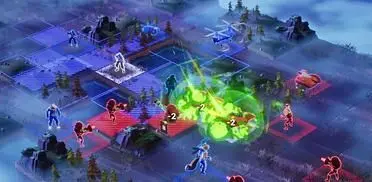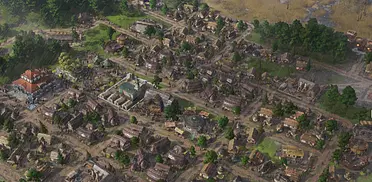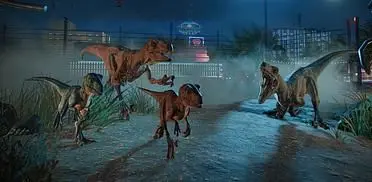Warhammer 40,000: Space Marine Master Crafted Edition’s announcement didn’t come off as that much of a surprise following the success of its sequel. In an age of remasters and remakes that polish and alter classic games to different extents, it felt natural for Captain Titus’ initial battle against the enemies of Mankind to make its way back into the spotlight, even if it does so without too many changes.
Released fourteen years ago, the original Space Marine likely went under the radar of many who’ve enjoyed its shinier, more boisterous follow-up. This remaster takes a light, straightforward approach, opting to preserve the original’s story, structure, and gameplay, while mainly working on ensuring it’s better suited to run on modern hardware.
The Master Crafted Edition’s improved character models take center stage from the first moments of the campaign, with its main cast and villains looking sharper. The improved environmental textures more readily show their age, but that’s a symptom of the game being developed over a decade ago.
Level geometry remains fairly simple, while Graia’s industrial landscapes – although offering some variety between ruins, rubble, and the innards of its manufacturing facilities – share a certain drabness. Although fitting for a Forge World, it almost cracks immersion after being exposed to the glorious vistas of its sequel.
Warhammer 40,000: Space Marine Master Crafted Edition also does a decent job of overhauling the UI, making its elements smaller and repositioning them to take up less space on the screen. The bulky section dedicated to your equipped weapon that used to be on the lower right side has been changed to much smaller stylized icons that use numbers to communicate ammo counts.
The Fury Meter now finds itself in the upper left corner, next to the health bar. Although they now free up space, there is an argument to be made about them being, perhaps, a little too small. You’re also met with a sleeker weapon selection menu, but the bar that used to fill up when holding the button to play servo-skull recordings is now missing in action.
Sound-wise, the Master Crafted Edition doesn’t feel like a complete revamp, carrying a decidedly “old” quality, especially in terms of voices. Noticeable changes affect its levels, which now benefit from a more engrossing wartime ambience alongside fewer instances of characters seemingly talking right into your ear.
The keyboard controls remain largely familiar but require a bit of getting used to unless you’re willing to rebind them. By default, you perform melee attacks using the right mouse button and aim ranged weapons with the CTRL key.
The remaster also instantly recognized my DualSense controller – which wasn’t the case for the original’s Anniversary Edition – and I could choose between classic and modern control schemes. Seamless switching between keyboard and controller might not feel necessary, but is a nice added touch, provided you do not bump into the same problem as I did.
Unfortunately, a good chunk of the time I spent with the campaign was plagued by an annoying bug that would render my screen black while drowning out the sound. This forced me to restart checkpoints multiple times per chapter, turning the six-hour adventure into a bit of a slog. I tinkered with resolution and the few graphical settings on show, switched between fullscreen and windowed mode, and shut down as many processes as I could, all to no avail.
Only unplugging my controller while adding “-windowed” in the Steam launch options fixed Space Marine’s black screen issue for me. I’m not entirely convinced the latter did much, since the game continued to run in fullscreen, but this allowed me to push through the final third of the campaign unhindered.
This wasn’t the end of the world, but definitely not something I expected to deal with when playing a remaster expressly targeting ease of play on modern systems.
Aside from these changes, Warhammer 40,000: Space Marine remains untouched. Its short campaign alternates between fairly intense encounters across combat arenas of different sizes and brief moments of respite while trekking through a Forge World ravaged by not one, but two invasions.
It succeeds at capturing the power fantasy of embodying one of the Emperor’s most powerful servants as well as it originally did, acting as a reminder of why gloriously mowing down Orks and Chaos troops with the Ultramarines’ blessed arsenal gave the game its cult classic status.
As you progress, weapon stations unlock new additions and upgrades. The lascannon is all about power and precision, the vengeance launcher lets you fire sticky ammunition that’s manually detonated, while the daemonhammer restricts the use of most ranged weapons but packs a serious wallop.
The latter is sometimes paired with a jump pack that lets you soar above your enemies and slam into them, which also happens to be one of the best ways to turn the Emperor’s enemies into red mist.
There are limitations in terms of which weapons you can swap for others, which makes it harder to fit weapons like the storm bolter into your regular loadout. Although a bit of extra flexibility would have been welcome here, this is far from a dealbreaker.
The enemy AI remains easy to exploit and kill from afar without them truly fighting back, even when it doesn’t get stuck on geometry. Not all arenas allow for this approach so charging headfirst into a pack of melee foes backed by elite gunners or Meganobz may not always be the best idea.
Although there is some enemy variety, their behavior alongside Titus’ arsenal and mechanics don’t quite manage to stave off repetition, which begins to set in by the halfway point of the campaign.
When facing stronger opponents up close – or if you’re ever in a bind without nearby foes to stun and execute for a health refill –, Fury mode empowers your attacks and heals you, temporarily turning you into an even beastlier war machine.
It takes a while to recharge, though, so tactically eliminating high-priority targets remains crucial and thoroughly satisfying, even when you know that the heavily armored Chaos Space Marine sniper on the other side of the level is woefully unprepared for your epic strafing skills.
Space Marine’s narrative is fine, steadily giving you reasons to push on and slay Orks and Chaos without ever tangling its threads. Its main baddies are serviceable villains, but their boss fights have aged terribly.
Clunkily dodging slow charges in a relatively small arena while filling Warboss Grimskull with lead and facing off against a Daemon Prince in a tedious quick-time event-based battle pale in comparison to dealing with scores of their minions. Still, these are short encounters in an otherwise flawed but nonetheless fun campaign.
Multiplayer offers five PvP modes – including annihilation and capture the flag – alongside the horde-style Exterminatus mode, in which you join fellow players and fight AI waves while trying to complete dynamic challenges. Most of my matches were, however, plagued by lag, likely caused by the peer-to-peer matchmaking system.
While, in some cases, it just translated to players jankily moving around, I was forced to outright quit a few, after connection errors trapped me in a limbo where nothing moved around me.
Outside of these moments, playing the modes can be fun in short bursts, but a shiny coat of paint is unlikely to render them populated for too long, even if multiplayer is the only place that allows you to play as Chaos. During its first days, half of the lobbies I was in also struggled to fill all player slots.
Performance
On an i7-13700K, 32 GB RAM, and Nvidia RTX 3080@1440p, Warhammer 40,000: Space Marine Master Crafted Edition ran flawlessly, save for the black screen issue mentioned above and one or two jarring lighting transitions in one of its early chapters. Perhaps unsurprising for an old game, but nonetheless great, especially if, like me, your PC wasn’t quite up to snuff for the original.
WARHAMMER 40,000: SPACE MARINE VERDICT
Warhammer 40,000: Space Marine Master Crafted Edition is an adequate remaster that makes 2011’s third-person action game easier to play on modern machines while improving how it looks and sounds. None of its additions address the original’s fundamental issues, preferring to leave it largely as it was.
Its flawed but fun campaign delivers plenty of visceral slaughter while its multiplayer is worth dipping into for a few matches every now and then, provided you don’t run into lag and find enough players to fill a lobby.
It’s easy to see why the game became a cult classic, but for what it offers, the remaster’s price tag and the lack of an upgrade option or discount for existing owners are undoubtedly head-scratchers.
TOP GAME MOMENT
Crashing into a very unfortunate squad of orks using Captain Titus’ jump pack and turning them into red mist.
Good vs Bad
- Better character models and UI
- Keeps the original's spirit intact
- Slaughtering Orks and Chaos is still fun
- Costly, lacking upgrade option for existing owners
- Some bugs remain
- Retains the flaws of the original
- Laggy, unpopulated multiplayer lobbies











